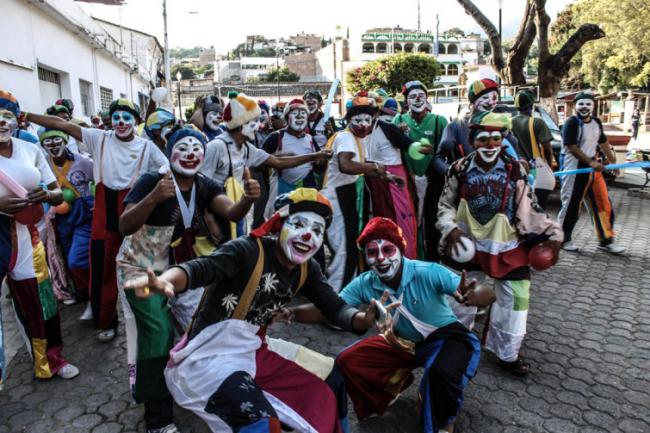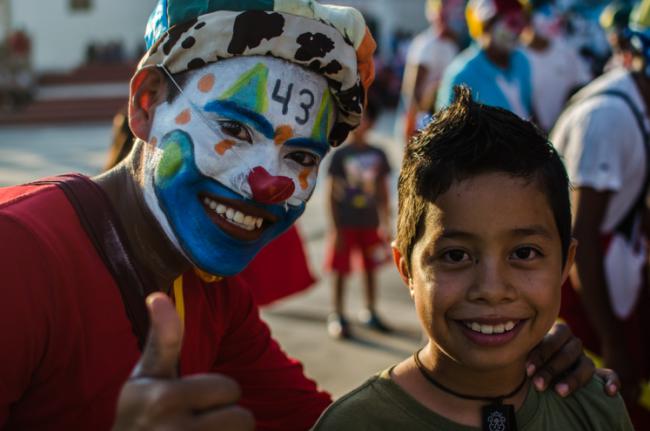NACLA partnered with Subversiones.org to translate their reporting of the growing resistance movement in Ayotzinapa. See original article in full here.
Video by Andalucía Knoll and Heriberto Paredes. See English video transcript below.
The accusations: “vandals,” “nonconformists,” and “organized criminals.” The accusers: social media users, politicians, and drug traffickers. Since the night of Sept. 26, when the attack against the Normalistas from the Isidro Burgos Normal School began to generate reactions that gradually mobilized society both nationally and internationally, insults towards the “Ayotzinapos” also began to increase.
Strangely, all of the slanderers who have felt legitimated through joining this smear campaign have blamed the protesters for being exactly what they themselves are: the people of Iguala and Chilpancingo, so uncompromising on Facebook, that they did not see themselves as equally irreproachable when they sacked the Commercial Center Tamarindos and the Aurrerá bodega. The lawmakers who slander them for not living up to their roles as future teachers are the same who, though elected to promote the public good, quickly become the protagonists of corruption and misrule. Denunciations that the Normalistas have been infiltrated by organized crime come, in the end, from none other than the United Warriors (Guerreros Unidos) cartel members themselves. In light of this discrediting plan, two fundamental questions arise: who, and why? Meaning, who really are the Normalistas, and why is their image stigmatized and vilified with such fury?

These “frightening ayotzinapos” begin their day at seven in the morning, with breakfast in the dining hall. Afterwards, they do classroom activities from eight to two in the afternoon in 50-minute-long sessions. After lunch, the students can go to workshops on topics that most interest them: carpentry, leatherwork, sculpture, painting, ballet, music, or sports. At seven in the evening, the academic day ends and students take part in organization and maintenance of the school. The structure is completely autonomous and self-organized. The students coordinate committees, each one dedicated to a specific task. Some students are in charge of cleaning, while others take care of the animals and the farm. The “Turtle Place” also houses horses, cows, bulls, and quails, and the students grow marigolds and velvet and take care of the milpa. The commission is orderly and disciplined, run by the “moral integrity” of the school.
This routine and these school customs don’t match up with the image of a place inhabited by perverse social agitators. The impression is instead one of a community that is disciplined, organized to make the most of the scarce resources it has—and above all, united. However, after the fatal night of Sept. 26, this unity no longer exists. The only thing that remains intact is the friendship and brotherhood that brings the students together. The students at the Normal School of Ayotzinapa aren’t just classmates, they are best friends.

So why this smear campaign against the Normalistas? Why does the media reproduce the discourse of the state and paint the Ayotzinapa students as second-class students? Because within the actions of the Normalistas, there is rebellion and dignity; there is dedication, discipline, delivery, resistance, and social consciousness; there is life in them that isn’t touched by the politics of death that the state tries to impose at all costs in order to turn a greater and greater profit. Because to resist in the streets and in classrooms, and in addition, to take the time and care to make children laugh, despite the pain of the absence of their 43 classmates, is in itself a subversive act—a praxis that goes against the capitalist logic of dehumanization.
All the scorn, all the condescension: it’s because the students of the Normal School of Ayotzinapa still laugh, despite the deaths of their classmates and the forced disappearances of many others. Because if they were to lose this capacity to smile, they’d be losing the battle before it began. Laughter, in the midst of this war of extermination, is a rebellious and subversive act that surely the great master and graduate of Ayotzinapa, Lucio Cabañas, never lost.

Video Transcript:
Tixtla, Guerrero, Oct. 29 2014
Students from the Raul Isidro Burgos Rural Normal School in Ayotzinapa, Guerrero, put on a clown show to provide relief for themselves and others in the wake of so much violence and desperation. The demand to return—alive—the 43 classmates who were disappeared this past September 26, 2014 remains strong.
Announcer: Now it’s time for all the clowns to come down…
Clowns singing
Christín: Our objective is to let society know that we the Normalistas are not criminals, and that today, we want to study, with the ultimate goal of helping the children.
It’s important to note that they’ve committed many acts of injustice against us, especially against our classmates who they disappeared, since their only crime was that they wanted to study to help out the children.
Announcer: Look at the beautiful clowns! There they are! Yea for clowns!
Chistín: The reason why we are here this afternoon is because it makes us uncomfortable, and it bothers us too, that so many children in our society, especially in Tixtla, are taught, perhaps by their parents and other people, to hate and fear us. We want to turn around and tell these parents and their children that that isn’t true, that we aren’t dangerous or bad people. That’s why we wanted to bring sodas and juices and prizes for the children, so they realize that what people are saying isn’t true.
Chistorín: We had the idea for this activity in order to bring the children some happiness. Many people on television have painted us as the bad guys, saying that we’re vandals, but we wanted to show the people a different side, that as Normalistas we also have sensitive side. We know how to work with children. We know how to organize with them and how to play with them. We believe that this will show the people that we’re not vandals, that what they’re hearing is a lie.
Clowns and children chant
Clown: A lagoon! No! We’ll have to swim! Swim swim swim!
The children and the clowns pretend to swim through the “moat.”
Clown 2: We’re strong! We can get home! We’re not afraid!
The children follow in unison.
Clown 2: What’s that I see?
Chistín: We are preparing to become elementary school teachers. We want the kids to see us as friends, as people they can trust. If we end up teaching them, we want them to feel like they can tell us their problems. That they want to invite us to their houses, things like that. We want them to see us as figures to look up to.
Javier González Méndez (Physical Education Teacher/Project Value of Learning Through Play): In the wake of so many problems, we wanted something to help calm down society. Society is in shock. It doesn’t know what to do. Publicity, on television, it’s all news of murders, graves. Everyone is in shock. Today, we get to be with our friends—and we are friends, we have done a lot of work together.
There is a third element that’s getting wrapped up in this problem. And it’s a worthless one. It’s the involvement of the children. Today, I observed my little girl come home asking me, “Who exactly are the Ayotzinapos?” with a sadness I could see reflected in her whole face. And it’s just not worth it, it’s not worth it to involve little children and hear them asking about the Ayotzinapos [with disdain]. She asked me this question so clearly: “Daddy, who are the Ayotzinapos?”
The clowns laugh and sing in high-pitched voices.
Chistorín: A lot of people try to discredit us, but with this type of event, they’re getting to learn who we really are, that we’re humble people, that we are capable of helping the children have fun.
Javier González Méndez: These kids needed a smile. There aren’t a lot of smiles here lately. But this is why we are teachers. With so much tension, we were missing the smiles. We want to show society that we can scream, but that we can smile too. That we’re supportive. That we can be overflowing with joy. That we’re human beings.
The clown is an image that everyone accepts. Especially when it has that flair of likeability. And this is what they were hoping to see—well, not what they were hoping, but we hope that to see people having fun with their children, having a good time, it’ll be a distraction from the many troubles. We want to be a source of support for these young kids.
The only thing I know is that the truth emerges at the right time. And the truth will emerge. The bad people will fall, and the good people will triumph. That is my life philosophy.
Chistín: We hope that today isn’t the last time we’ll be able to spend time with all of you and with all of your children. (In a high voice) So we’ll see you next time!
Heriberto Paredes and Eréndira Martínez are independent journalists and photographers and members of Agencia Subversiones (Subversions Agency). They both participate in other magazines such as Variopinto. This article originally appeared on Subversiones.org (CC BY-NC 2.0 México, 2014) on November 1, 2014. Translated by Laura Weiss.

